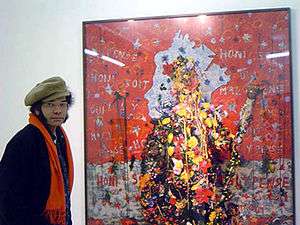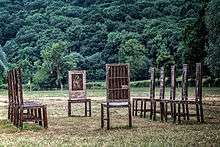Hew Locke

Hew Donald Joseph Locke (born 13 October 1959 in Edinburgh) is a sculptor and contemporary British visual artist based in Brixton, London.
Background
Born in Edinburgh, Scotland, in 1959, Locke is the eldest son of Guyanese sculptor Donald Locke (1930–2010)[1] and British painter Leila Locke (née Chaplin) (1936-1992).[2] He spent his formative years (1966 to 1980) in Georgetown, Guyana, before returning to the UK to study.[3] He received a B.A. Fine Art in 1988 from Falmouth University, and an M.A. Sculpture from the Royal College of Art, London in 1994. In 1995 he married curator Indra Khanna.[4] He is represented by Hales Gallery, London.
Career
Locke first came to national attention in 2000 when he won both a Paul Hamlyn Award[5] and the EASTinternational Award and installed Hemmed In Two as part of the contemporary arts programme at the Victoria and Albert Museum, London. This was followed by the creation of Cardboard Palace, a major new installation for his solo show at the Chisenhale Gallery, London (2002).[4]
Exhibitions
Since then, he has exhibited widely, with solo shows at venues including Luckman Gallery, California State University (2004), The Atlanta Contemporary Art Center, USA (2004), The New Art Gallery Walsall (2005), Rivington Place, London (2008), ArtSway, Hampshire (2011), Kunsthal KAdE, Amersfoort, the Netherlands (2011) and Hales Gallery, London (2005, 2008, 2010, 2014). His works are included in major group shows, such as Prospect New Orleans, Biennial, New Orleans (2014), Kochi-Muziris Biennale, India (2014), Glasstress White Light/White Heat, Palazzo Cavalli Franchetti, Venice (2013), Holy Toy Sølvberget Galleri, Stavanger, Norway (2010), The 2nd Thessaloniki Biennale of Contemporary Art, Greece (2009), South South Justina M. Barnincke Gallery, University of Toronto, Canada (2009), Infinite Island: Contemporary Caribbean Art Brooklyn Museum, USA (2007), British Art Show 6 BALTIC Gateshead (2005) and Barrocos y Neobarrocos Salamanca, Spain (2005).[4]
Collections
In Britain these include The Government Art Collection, The Tate Gallery, The Arts Council England, The Victoria and Albert Museum, The British Museum, The New Art Gallery Walsall and The Henry Moore Institute. In the USA they include The Brooklyn Museum and The Arnold Lehman Collection, New York, The Pérez Art Museum Miami, and The Kemper Museum of Contemporary Art, Kansas City.[4]
Public art
%2C_Runnymede%2C_UK.jpg)

His first performance piece Give and Take was presented at The Tate Turbine Hall (2014). Temporary installations include King Creole (2004), commissioned by the BBC for the launch of their New Media Village building, subsequently hung on the façade of Tate Britain, and For those in Peril on the Sea (2011), commissioned as part of the Folkestone Triennial and installed in the Church of St Mary & St Eanswythe. Permanent installations include Ruined (2010), ten 1.75m cast-iron markers in Brunswick Square Cemetery Gardens, Bristol, and Selene (2013), a bronze figure on the façade of the Nadler Soho Hotel, Carlisle Street, London.[4]The Jurors (2015) was commissioned to mark the 800th anniversary of the sealing of Magna Carta, and is sited at Runnymede, UK.[6]
Works and themes
Locke uses a wide range of media, including painting, drawing, photography, relief, fabric, sculpture and casting, and makes extensive use of found objects and collage. He has demonstrated an especial interest in working around sites and ideas with a historical resonance. He has cited architecture ranging from the Baroque, Rajput, Islamic, and Caribbean vernacular to Victorian Funfairs as influences.[7][8] Recurrent themes and imagery include visual expressions of power, trophies, globalisation, movement of peoples, the creation of cultures, ships and boats, and packaging.
Locke felt dogged in his early career by misreadings of his work. "It was seen as being from a folk tradition, not as being of its own tradition, true to itself - as art basically...I stopped making work in colour for three years, I just dropped it."[9]
Curator Kris Kuramitsu wrote of the genesis of Hemmed In Two and Cardboard Palace: "Frustrated by the fact that his biography so heavily over-determines the reading of his work, he created a series of sculptures in which he used cardboard to preemptively package the work for the viewer. This move was revelatory for Locke's practice, as through this material he could metonymically address migration, international economics, globalisation and ideas about personal and cultural protection and projection."[10]
Locke continued: "Then I started making fake Voodoo dolls: basically fake exotica. And that developed into the 'voodoo' Royal Family. I started to have fun with that question that all through the 90s had really annoyed me: 'Where do you come from?' i.e. 'You're not one of us. What are you?'"[9]
His ongoing series House of Windsor began as portraits of members of the British royal family, but now exclusively uses a portrait of Queen Elizabeth II for a symbolic framework. He has stated "My feelings about the Royal Family are ambivalent. I am simply fascinated by the institution and its relationship to the press and public. My political position is neither republican nor monarchist."[11]
Locke's investigation in the display of power has expanded into new areas such as royal and swagger portraiture, coats-of-arms, public statuary, trophies, masculinity, financial documents, weaponry and costume. He states: "This ...(is) essentially about power – who had it, who has it and who desires it."[4]
Impossible Proposals is an overarching title for series of works related to public statuary that include Natives and Colonials, Restoration and Sikandar. "It started as a proposal to get a statue-dressing project off the ground. Nobody was willing to take this project up, so the proposals...became the artwork...things I would never be allowed to do."[12]
Ships have been a constant theme in his work throughout his career, ranging from small paintings to installations filling a church nave or an installation across an entire battle ship.[13] He has said "I have a deep personal compulsion to make at least one boat every two years or so. It is part of my personal history, having sailed to and from Guyana to England as a child."[14] Curator Zoe Lukov has written "Locke offers us a maritime procession - at once celebratory and funereal - that is animated by the sub-marine pulse of history...a synthesis of symbols from intertwined historical and cultural legends and narratives...disparate legacies that surf the waves.."[15]
Share is a series working with imagery from, or physically working on, historical company share certificates. Indra Khanna has written: "Share certificates are a window into the history and movement of money, power and ownership. Newborn companies garlanded their shares with confident typography and classical motifs implying stability and worth ... they are one indication of where the big money flowed and pooled".[16]
Prof. Ingrid von Rosenberg has written: "(Black) Artists who continue to produce work with a critical message, like Yinka Shonibare and Hew Locke, avoid the open confrontation typical of the 1980s and instead use humour and satire, positioning themselves as cultural insiders, rather than excluded outsiders."[11]
Selected bibliography
- Diana Cooper Hew Locke, London: The Drawing Room, 2004, ISBN 0-9542668-2-X
- Hew Locke, Walsall: The New Art Gallery Walsall, 2005, ISBN 0-946652-77-5
- How Do You Want Me?, Paris: Editions Janninck, 2009, ISBN 978-2-916067-41-4
- Stranger in Paradise, London: Black Dog Publishing Ltd, 2011, ISBN 978-1-907317-38-5
Selected press
- Marcus Verhagen, "King of Clutter", Contemporary, issue 73, 2005.
- Jon Wood, "Photography, painting and impossible sculpture: Hew Locke's 'Natives and Colonials'", Sculpture Journal, volume 15.2, 2006.
- Pernilla Holmes, "Swords, Lizards and the Queen", ARTnews, October 2007.
- Ingrid von Rosenberg, "Transformations of Western Icons in Black British Art" Journal for the Study of British Culture, Vol. 15/1, 2008.
- Ben Luke, "Hew Locke", Art World, April/May 2008.
- Hew Locke in conversation with Richard West, Source, issue 55, summer 2008.
- Shan Peng, exhibition review of "Kingdom of the Blind", Art Monthly, October 2008.
- Barry Schwabsky, exhibition review of "The Nameless", Artforum, December 2010.
- Kobena Mercer, "Hew Locke's Post Colonial Baroque", Small Axe, issue 34, March 2011.
- Elizabeth Fullerton, "Every Toy Jaguar Has It's Place", ARTnews, April 2014.
External links
- Hew Locke website, retrieved 2011
- website dedicated to The Jurors by Hew Locke, retrieved 2015
- Artist Interview: Hew Locke Kochi-Muziris Biennale 2014 on YouTube, retrieved 2015
- Prisoners of the Sun: A conversation with Hew Locke and Prof. Kobena Mercer on YouTube, University of Miami, retrieved 2014
- Donald Locke website, retrieved 2011
- Indra Khanna website, retrieved 2011
- Tate: Meet the Artist: Hew Locke. The artist talks about his piece The Nameless, retrieved 2010
- BP Artists Talk: Hew Locke, in conversation with Marcus Verhagen. Tate Britain, retrieved 2014
References
- ↑ "Sculptor Donald Locke passes away", Stabroek News, 07/12/2011, retrieved 2011.
- ↑ Claudette Earl, Leila Elizabeth Locke - an appreciation, Chronicle Family Magazine, April 19, 1992.
- ↑ Duff, L., & P. Sawdon, Drawing - the Purpose, Intellect Ltd, 2008.
- 1 2 3 4 5 6 Hew Locke website, retrieved 2011.
- ↑ Jonathan Jones, "Five Card Trick", The Guardian Weekend, 30 September 2000.
- ↑ http://artatrunnymede.com/
- ↑ Review of "Cardboard Palace", Ellie Duffy, Building Design magazine, issue 1529, 29 February 2002.
- ↑ Review of "Cardboard Palace", Jonathan Jones, Contemporary magazine, June 2002, p. 160.
- 1 2 Hew Locke in conversation with Richard West, Source magazine, issue 55, p. 9, summer 2008.
- ↑ Hew Locke, The New Art Gallery Walsall, 2005.
- 1 2 Ingrid von Rosenberg, "Transformations of Western Icons in Black British Art", Journal for the Study of British Culture, Vol. 15/1, 2008.
- ↑ Jon Wood, "Photography, painting and impossible sculpture: Hew Locke's 'Natives and Colonials'", Sculpture Journal, vol. 15.2, p. 282, 2006.
- ↑ Hew Locke website/boats, retrieved 2016.
- ↑ "Second Lives: Remixing the Ordinary'", Museum of Arts & Design, ISBN 1-890385-14-X.
- ↑ "Hew Locke - The Wine Dark Sea", catalogue published by Edward Tyler Nahem Fine Art, 2016.
- ↑ Indra Khanna, "Share", "Stranger in Paradise", p. 62.
| Wikimedia Commons has media related to Hew Locke. |
